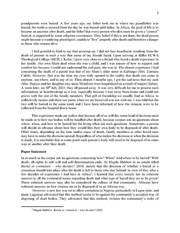File:BURIAL ORIGINAL.pdf

Original file (1,275 × 1,650 pixels, file size: 310 KB, MIME type: application/pdf, 16 pages)
Captions
Captions
Summary edit
| DescriptionBURIAL ORIGINAL.pdf |
English: It was Stephen Prothero who said in the introductory part of his book, titled Purified by Fire: A History of Cremation in America, 2001; that in every human society the living care for the dead. This care may include cleaning it, shaving it, dressing it, putting it on display, speaking to it, praying over it, caressing it, lavishing praise on it, offering it food, and otherwise facilitating its entrance into whatever, if anything, lies ahead. Closing the eyes and mouth of the deceased Straightening the limbs, covering the deceased, often with a sheet, placing a candle near the head of the deceased, opening the windows in the room (if weather is problematic, windows are opened briefly, then closed again), etc. When all is said and done, however, a dead body has to be disposed of, banished, so the living could continue with their task . This statement is true of Africa, especially in Dikaka’s tradition. It is in Africa where you will see the living fighting, staying hungry, and putting a stop to their activities to care for the dead, some Africans may even kill to secure the corpse of a loved one. In the African worldview, death is not the end of the journey, but a glorious beginning to join the ancestors. It is a belief that gives solace to hearts pinned in pain after the demise of a loved one. This work explores instances in the Bible where the funerary practices are done in relation to culture and identifies a common pattern, attempts an explanation of the meaning of burial and cremation in relation to Jesus and use that understanding to interpret the problem of cremation and give a concluding statement. |
| Date | |
| Source | Own work |
| Author | Jurgoi Saleh Jnr. |
Saleh, Jurgoi is a teacher and speaker of God's Word and is deeply committed to soul winning and training of young men for kingdom services. He hails from Mona-Cham in Balanga Local Government Area of Gombe State, Nigeria. In his quest for education, Jurgoi attended Government Science Secondary School (GSSS), Billiri, where he obtained SSCE. He went to Billiri ECWA Theological College (BETC), where he obtained Bachelor of Arts in Pastoral Theology. He is a Post-graduate student with Jos ECWA Theological Seminary (JETS). He served as the Pastor of ECWA Goodnews Church Cham, located in Gombe State and a care taker secretary to Mona Student Association (MOSA). He is also the author of You Can Do Better: Don't Let Your Background Put Your Back on the Ground. He has a mandate to wipe out tears, restore people to their original fellowship with the Lord Jesus Christ, through preaching of the Word. He is also the National Secretary for Nigeria Cryout Youth Initiatives (NCYI).
Licensing edit
- You are free:
- to share – to copy, distribute and transmit the work
- to remix – to adapt the work
- Under the following conditions:
- attribution – You must give appropriate credit, provide a link to the license, and indicate if changes were made. You may do so in any reasonable manner, but not in any way that suggests the licensor endorses you or your use.
- share alike – If you remix, transform, or build upon the material, you must distribute your contributions under the same or compatible license as the original.
File history
Click on a date/time to view the file as it appeared at that time.
| Date/Time | Thumbnail | Dimensions | User | Comment | |
|---|---|---|---|---|---|
| current | 06:44, 25 June 2022 |  | 1,275 × 1,650, 16 pages (310 KB) | Jurgoi Saleh Jnr. (talk | contribs) | Uploaded own work with UploadWizard |
You cannot overwrite this file.
File usage on Commons
There are no pages that use this file.
Metadata
This file contains additional information such as Exif metadata which may have been added by the digital camera, scanner, or software program used to create or digitize it. If the file has been modified from its original state, some details such as the timestamp may not fully reflect those of the original file. The timestamp is only as accurate as the clock in the camera, and it may be completely wrong.
| Author | Jurgoi Saleh Jnr. |
|---|---|
| Software used | Microsoft® Word 2019 |
| Date and time of digitizing | 18:39, 23 June 2022 |
| File change date and time | 18:39, 23 June 2022 |
| Conversion program | Microsoft® Word 2019 |
| Encrypted | no |
| Page size | 612 x 792 pts (letter) |
| Version of PDF format | 1.7 |
